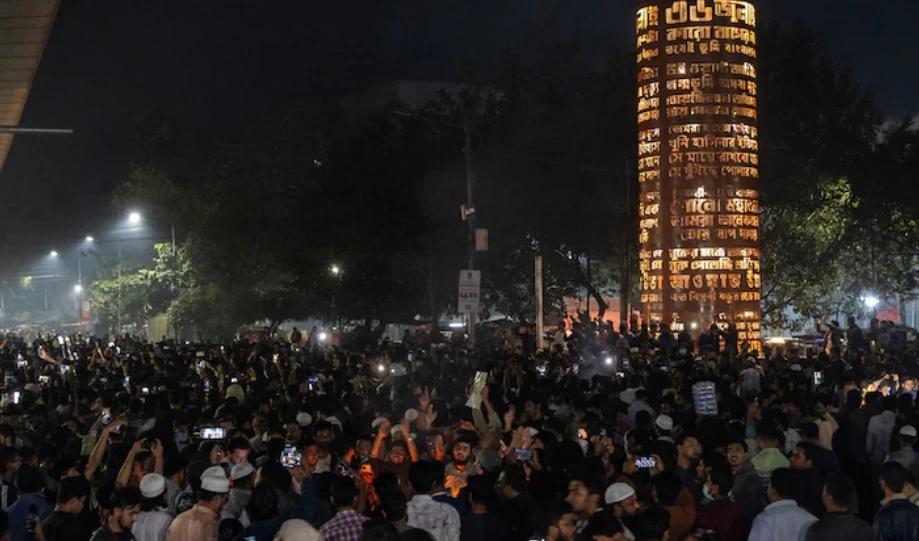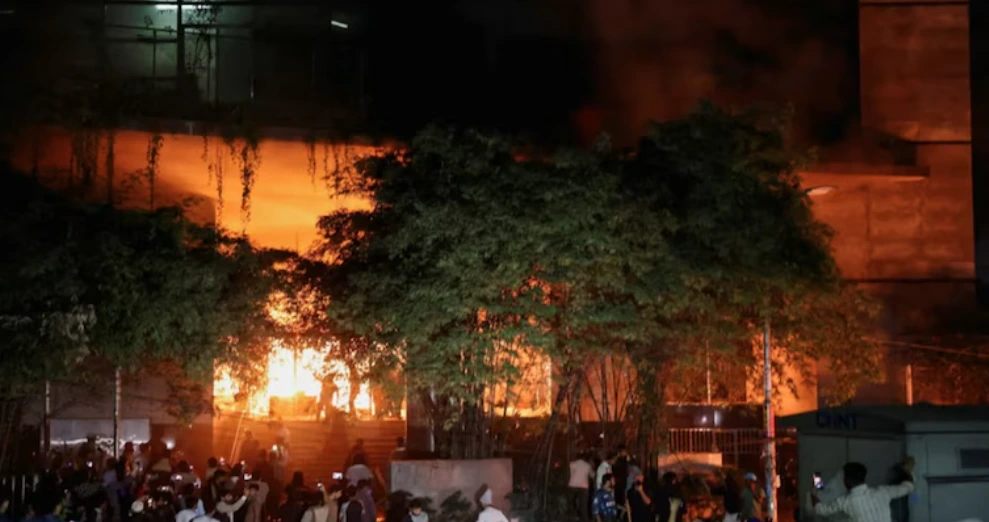Latest world news
BRICS Summit against Backdrop Of Plummeting Washington-Moscow Relations
Published
8 years agoon
By

[vc_row][vc_column][vc_column_text]
By: Saeed Naqvi
Two recent events will influence attitudes at the 9th BRICS summit at Xiamen, China, from September 3 to 5 – Doklam and Trump’s decision to send more troops to Afghanistan.
Beijing and Moscow have grave anxieties about terrorist groups, in the name of militant Islam, threatening their Xinxiang and Caucasus regions. They would therefore like terrorism to be an important theme at the summit.
So would New Delhi, but the Indian focus would be on Pakistan as the source of terror. The complication is that Pakistan has looked upon China as an all weather friend in recent years. Has skillful diplomacy, on all sides, defused the Doklam standoff sufficiently to prevent divergent approaches to Pakistan on terrorism come to the fore at the summit?
Moscow is cautious. Who knows how durable is the understanding reached over Doklam between Beijing, New Delhi.
That a RIC (Russia, India, China) Foreign Ministers conference is billed in New Delhi is a good sign. It was postponed in April because of heated exchanges between China and India over Dalai Lama’s weeklong visit to Arunachal Pradesh. Also, New Delhi had refused to attend the Belt and Road conference Beijing placed great store by. Indeed, New Delhi also prevailed on Thimpu not to attend.
Moscow and Beijing view Afghanistan as the centre where terrorist groups like the Islamic State can breed and threaten countries in the neighbourhood and beyond.
Since April 2016 a group of countries under the auspices of what came to be known as the Moscow initiative began to analyze the Taleban as an Afghan, nationalist category which was not fired by transnational aspirations like the IS and Al Qaeda. The Taleban, in other words, should be brought into the tent, to borrow Lyndon Johnson’s colourful expression.
This is a transformational design because so far the government in Kabul, Afghan security Forces, US and NATO Forces have targeted the Taleban as the enemy.
The use of this massive firepower, with western troop levels waxing and waning over the past 16 years, has not brought the alliance anywhere near victory. To the contrary, the terrain under Taleban control has grown exponentially. Defence Secretary James Mattis became only the umpteenth US official to declare before the media, his face in the lower mould: “we are losing.”
This candid acceptance of defeat in the longest war (16 years) ever waged by the US, has coincided with the Moscow led initiative to bring the Taleban into the Kabul power structure.
The Moscow initiative was designed against the backdrop of Trump’s chant of walking away from previous US policies of intervention and nation building. Since the US was withdrawing, as Trump kept reminding all and sundry, it made sense for Moscow, Beijing, Tehran, Islamabad and the Central Asian Republics, to shape their Afghan policies according to their strategic requirements.
In a White House where the Deep State is demonstrably the ventriloquist and Trump the puppet, a flip-flop in Afghan policy was announced last week: there will be no withdrawal but a minimal troop surge (less than 4,000 to augment 11,000 already on the ground) to enable Kabul to recover some of the vast swathes of the country from Taleban control. Somewhere in this pursuit of a military solution, a carrot has also been inserted: a channel for talks with Taleban will also be opened.
To dignify this US initiative, the Moscow initiative has to be rubbished. Russians have been arming the Taleban, goes the allegation from Washington. Russian Foreign Minister, Sergey Lavrov, clarified this and more at a Moscow Press conference.
When the US State Department made this accusation, he said, the Department should have known better. “Because at a news conference in the State Department, journalists asked the official spokesperson to present facts. Not a single fact was presented just like there was not a single fact to confirm our interference in the US election or breaking into sites.”
Lavrov contrasted Moscow’s policy with that of Washington on contacts with Taleban. He gives two reasons for such contacts. First, Moscow needs to resolve practical issues on which security of Russian citizens and offices in Afghanistan depend.
“Second we are striving to encourage a dialogue between the Taleban and the government on the basis of criteria (this is important, he insists) established by the UN Security Council.”
According to this “criteria” the Taleban must break ties with terrorists, end the armed struggle and respect the Constitution of Afghanistan. Washington’s abrupt policy of connecting with Taleban is without any conditions.
The fine print the Russians read in the US script on Afghanistan is not difference from what Lavrov has openly said in other theatres of conflict. The US is not out to douse fires of militancy: it intends to preserve some of it as “assets” against rivals and enemies. Breeding of the Mujahideen to evict the Soviets from Afghanistan in the 80s was not a one time trick.
Trump’s Afghan surge, despite himself, also comes at a time when he has been persuaded by his hawks to ratchet up tensions with Russia. The Russian Consulate in San Francisco has been closed and two other Russian properties in Washington and New York have been ordered to be shut by September 2.
This being the big-power play in the region, how should New Delhi respond to Trump’s cajolery in Afghanistan? To frame policy, friends in South Block have to do no more than visit Saket in South Delhi. You cannot walk into Max hospital without coming face to face with an Afghan. By universal consent of doctors and other hospital staff, they are the most gentle patients. This outreach cannot be matched.
In front of the hospital, in Hauz Rani, a row of Afghan eating places has come up.
Pakistanis stepping out of Kabul’s Serena hotel do not wear Peshawari sandals and Pathan suits. They feel safer in trousers and bush shirts, looking like Indians. Hospitals, schools, roads and, above all, Bollywood have already won Afghan hearts. Nothing should be done to upturn this low key, common sense policy. Expeditious completion of Chabahar port in Iran, linking to Central Asia by a road through Afghanistan will be brilliant for commerce and for winning hearts and minds.
What must not be overlooked is the change in US policy towards New Delhi’s role. When President Barack Obama announced troop withdrawals from July 2011, the assumption was that Afghanistan would have been reasonably stabilized by that date.
US Force Commander Gen. Stanley McChrystal created something of a flutter in New Delhi. He said New Delhi’s popularity among the Afghans – because of development works – creates complications because it distracts Pakistan from its war on terror focus.
Washington’s new blandishments make one feel good but they would be more valuable if the reliability quotient of the occupant of the White House was a shade higher.
The principals sitting around the table at the Xiamen summit likewise will carry in their minds the image of what to each one of them is a very different kind of Presidency in Washington. No one quite knows what to make of it.
[/vc_column_text][/vc_column][/vc_row]
You may like
-


Nitin Nabin terms BJP working president role a party blessing, thanks leadership
-


Trump warns of new tariffs on India over US rice dumping concerns
-


Rahul Gandhi attacks Centre ahead of Vladimir Putin’s India visit
-


Trump pledges permanent pause on migration from Third World countries in Thanksgiving message
-


Elon Musk attends Trump–Saudi prince dinner amid signs of reconciliation
-


Trump defends tariffs, promises $2,000 dividends to Americans
Latest world news
Hindu man lynched and set on fire in Bangladesh during anti-India protests
A Hindu man was lynched and set on fire in Bangladesh’s Mymensingh district amid rising anti-India protests after the death of a radical student leader.
Published
2 days agoon
December 19, 2025
A disturbing incident of mob violence against a minority community has been reported from Bangladesh, where a Hindu man was lynched and his body set on fire amid escalating anti-India protests following the death of a radical student leader.
Mob lynching reported from Mymensingh district
A 30-year-old Hindu man, Dipu Chandra Das, was lynched by a mob in Bhaluka Upazila of Mymensingh district after allegations surfaced that he had insulted Islam. According to media reports, the incident took place on Thursday night at an industrial area where Das was employed.
Das was accused of making derogatory remarks about Islam and Prophet Muhammad during an event organised at his workplace to mark World Arabic Language Day. The allegations spread rapidly within the factory premises and nearby areas, leading to heightened tension.
Eyewitness accounts cited in media reports said Das was assaulted by an angry crowd and died on the spot. After his death, the mob allegedly tied his body to a tree, beat it while raising slogans, and later set it on fire.
Body burnt at multiple locations, traffic disrupted
The violence did not stop there. Reports suggest the mob later moved Das’s body to a nearby bus stand area and again set it ablaze. Subsequently, the body was taken to the Dhaka–Mymensingh highway, where it was burned once more, leading to panic among locals and a temporary disruption of traffic on the busy stretch.
Confirming the incident, the local administration said a person was killed following allegations of insulting the Prophet. Officials added that the body has been taken into police custody and the situation is being monitored.
Interim government condemns violence
The lynching took place against the backdrop of widespread protests across Bangladesh following the death of Sharif Osman Hadi, a prominent leader linked to the July Uprising. The Muhammad Yunus-led interim government strongly condemned the killing, stating that there is no place for such violence in the country.
In an official statement, the government appealed to citizens to reject hatred and violence, stressing that those responsible for the crime would not be spared.
Anti-India sentiment intensifies after Hadi’s death
Tensions have been high in Bangladesh since Hadi’s death, with protests, vandalism and arson reported in several cities. Demonstrators targeted prominent media offices and symbolic locations linked to the country’s political history.
Hadi was known for his sharp criticism of India and the former prime minister, whose government was ousted during last year’s uprising. Groups formed after the political upheaval have been actively mobilising street protests and campaigns that fuel anti-India sentiment, particularly after the former premier went into exile in India.
The lynching of Dipu Chandra Das has further raised concerns over the safety of minority communities amid the ongoing unrest in the country.
Latest world news
Bangladesh rocked by violent protests after student leader Sharif Osman Hadi’s death, anti-India slogans raised
Bangladesh has witnessed widespread violence and protests following the death of student leader Sharif Osman Hadi, with arson, anti-India slogans and a nationwide security clampdown.
Published
3 days agoon
December 19, 2025
Violent protests erupted across Bangladesh after the death of student leader and political figure Sharif Osman Hadi, triggering fresh instability in the country and a sharp rise in anti-India sentiment. The situation turned volatile in Dhaka and several other cities as thousands of demonstrators poured onto the streets demanding swift action against those responsible for his killing.
Hadi, 32, was shot in the head by masked assailants while launching his election campaign in Dhaka last Friday. He was later airlifted to Singapore for treatment, where he succumbed to his injuries. Known for his polarising views and strong anti-India rhetoric, Hadi had emerged as a prominent face during the 2024 student uprising that led to the ouster of former prime minister Sheikh Hasina.
Fires, arson and tense streets in Dhaka
Soon after news of Hadi’s death broke, protests intensified in the Bangladeshi capital. Several buildings, including those housing leading media organisations, were set on fire, with authorities confirming that staff members were trapped inside during the blaze. Fire services later said the situation was brought under control, while security forces were deployed in large numbers to prevent further violence.
Demonstrators were seen chanting slogans invoking Hadi’s name, vowing to continue protests until those behind the attack were arrested. Multiple areas in Dhaka remained tense late into the night as police and paramilitary units attempted to restore order.
Protests spread, Indian mission targeted in Chittagong
Violence was not limited to the capital. In the port city of Chittagong, protesters gathered outside the Indian Assistant High Commission, raising anti-India slogans amid heightened anger on the streets. Similar unrest was reported from other parts of the country, signalling the widening scale of the crisis.
In Rajshahi, demonstrators torched Bangabandhu Sheikh Mujibur Rahman’s residence and an Awami League office, causing extensive damage. Authorities have not yet released a detailed assessment of losses, but security has been tightened across sensitive locations.
Anti-India sentiment deepens diplomatic strain
The latest unrest comes amid deteriorating ties between India and Bangladesh following Sheikh Hasina’s flight to Delhi. Earlier in the week, protesters under the banner of “July Oikya” marched towards the Indian High Commission in Dhaka, demanding Hasina’s return and raising hostile slogans against India.
India has formally conveyed its concerns to Dhaka over threats to its diplomatic missions and inflammatory statements by Bangladeshi political figures. New Delhi has rejected allegations linking India to the attack on Hadi, calling such claims false and misleading.
Yunus calls for calm, state mourning announced
In a televised address, interim chief Muhammad Yunus described Hadi’s death as an “irreparable loss” to Bangladesh’s political and democratic space. He urged citizens to exercise restraint, warning that continued violence could derail the country’s path towards a credible election.
The interim administration has announced a day of state mourning in Hadi’s honour, with national flags to fly at half-mast and special prayers planned nationwide. Bangladesh has been under an interim government led by Yunus since August 2024, with national elections scheduled for February 12.
India issues advisory for its nationals
Amid the unrest, the Indian High Commission in Dhaka issued an advisory asking Indian nationals in Bangladesh to avoid non-essential travel and limit movement outside their residences. Emergency contact details of Indian missions have been shared for assistance.
Manhunt launched for attackers
Bangladesh police have launched a manhunt for those behind Hadi’s killing, releasing photographs of two suspects and announcing a reward of five million taka for information leading to their arrest. Yunus has described the attack as a premeditated attempt by a powerful network to sabotage the electoral process.
Latest world news
India closes two more visa centres in Bangladesh amid worsening security concerns
India has temporarily closed visa application centres in Rajshahi and Khulna, citing security concerns following protests near Indian establishments in Bangladesh.
Published
3 days agoon
December 18, 2025
India has shut two additional Indian Visa Application Centres (IVACs) in Bangladesh — in Rajshahi and Khulna — citing the prevailing security situation in the country. The move comes a day after protests were held near the Indian High Commission in Dhaka by radical groups, raising concerns over safety around Indian establishments.
An official notification issued on the IVAC website said the centres in Rajshahi and Khulna were closed on December 18 due to security reasons. Applicants who had appointments scheduled for the day have been assured fresh slots at a later date.
The decision follows the temporary shutdown of the visa application centre in Dhaka earlier, even as New Delhi flagged a rise in open hostility towards India, particularly targeting the northeastern region, under the interim government led by Muhammad Yunus.
Bangladesh rejects India’s security assessment
Bangladesh’s Foreign Affairs Advisor Touhid Hossain dismissed India’s concerns and denied any deterioration in law and order. He distanced the interim administration from recent inflammatory remarks made by National Citizen Party (NCP) leader Hasnat Abdullah, who had publicly threatened to cut off India’s “seven sisters” and also issued comments against the Indian High Commissioner.
Hossain said the individual was not part of the government and termed his statements irrelevant. He also claimed that security arrangements were in place and that the shutdown of the Dhaka visa centre coincided with a local programme, which raised security-related questions.
Political backdrop and India’s response
The NCP, which emerged from student-led protests that led to the fall of the previous Awami League government, has extended support to the Yunus-led interim setup. Though the party has limited political presence, radical elements associated with it have organised anti-India demonstrations in Dhaka.
India, in an earlier statement, urged the interim government to ensure internal law and order and hold peaceful elections so that Bangladesh can return to an elected administration. However, the interim government appeared dismissive of this advice, with Hossain stating that India need not advise Dhaka on conducting elections.
Observers in Bangladesh have pointed out that delays in elections could benefit the unelected interim government, while radical groups may attempt to create disruptions by projecting India as a hostile actor. New Delhi has so far maintained a measured stance, despite remarks that directly question India’s sovereignty and territorial integrity, particularly in the northeastern region.

India announces T20 World Cup 2026 squad, Shubman Gill dropped as Axar Patel named vice-captain

Veteran Malayalam actor and filmmaker Sreenivasan passes away at 69

T20 World Cup 2026: Selectors weigh Shubman Gill role as India squad announcement awaited

Thick smog engulfs Delhi, flights and trains delayed as air quality slips to very poor





